Silky-smooth, creamy and perfect for piping, Swiss Meringue Buttercream is one of my favourites and I’m sure it’ll become yours too. No graininess and not as sugary as many others, it’s the perfect frosting.
While this frosting may sound intimidating or complicated, I promise you’ll be rewarded with something so utterly moreish, you won’t be able to resist using it on everything.
You can see this buttercream used on my Black Velvet Cake. My other two favourite frostings – Ermine buttercream and this German buttercream.
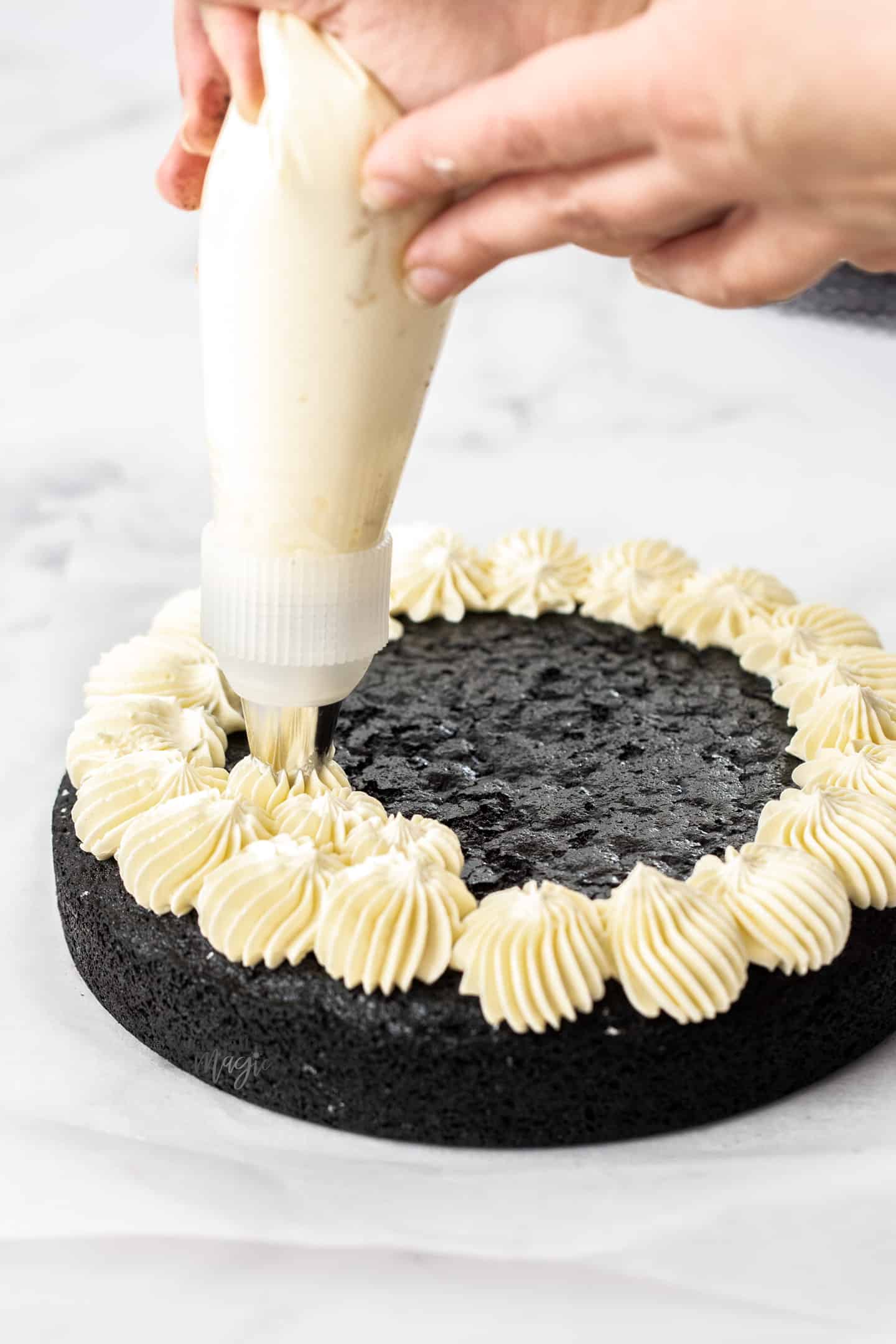
Table of contents or skip straight to the recipe
- What is Swiss meringue buttercream
- Why should you make this recipe?
- Is it very buttery in flavour?
- Ingredients you’ll need
- Helpful tools
- How to make Swiss meringue buttercream
- What are stiff peaks?
- How to flavor Swiss buttercream?
- Troubleshooting guide
- How to store Swiss meringue buttercream
- FAQs
- How to use Swiss meringue buttercream
What is Swiss meringue buttercream
Swiss meringue buttercream is a meringue based buttercream – that’s to say, it’s made in two stages, starting with the meringue first, to which butter is added until you have a thick, whipped, creamy buttercream.
It’s smooth, a little more stable than other butter based buttercreams and not as sweet as most. It also has a more buttery flavour than other buttercreams. Rich, silky and delicious.
It starts with sugar and egg whites being heated together (only for about 5 minutes) until it reaches a temperature whereby the eggs are safe to eat. This mixture is whipped up to stiff peaks. Gradually butter is added to the mix.
This post will give you all the tips you need to make a perfect batch of Swiss meringue buttercream and includes troubleshooting for any pesky little issues that may (or may not) pop up. I promise, if you follow this guide, you’ll have no troubles.
Why should you make this recipe?
- All the tips you need
- It’s not sickeningly sweet
- Thick and silky smooth
- Just 5 ingredients
Is it very buttery in flavour?
Since Swiss buttercream is mainly egg whites, sugar and butter it does have a buttery flavour. My buttercream uses less butter than many recipes so while you can taste the butter, it doesn’t taste like you’re eating a stick of it. Adding just a little vanilla goes a long way and will tame that butter flavour.
Ingredients you’ll need
There are just 5 ingredients in this luscious, vanilla Swiss meringue buttercream and you likely have them all on hand right now.
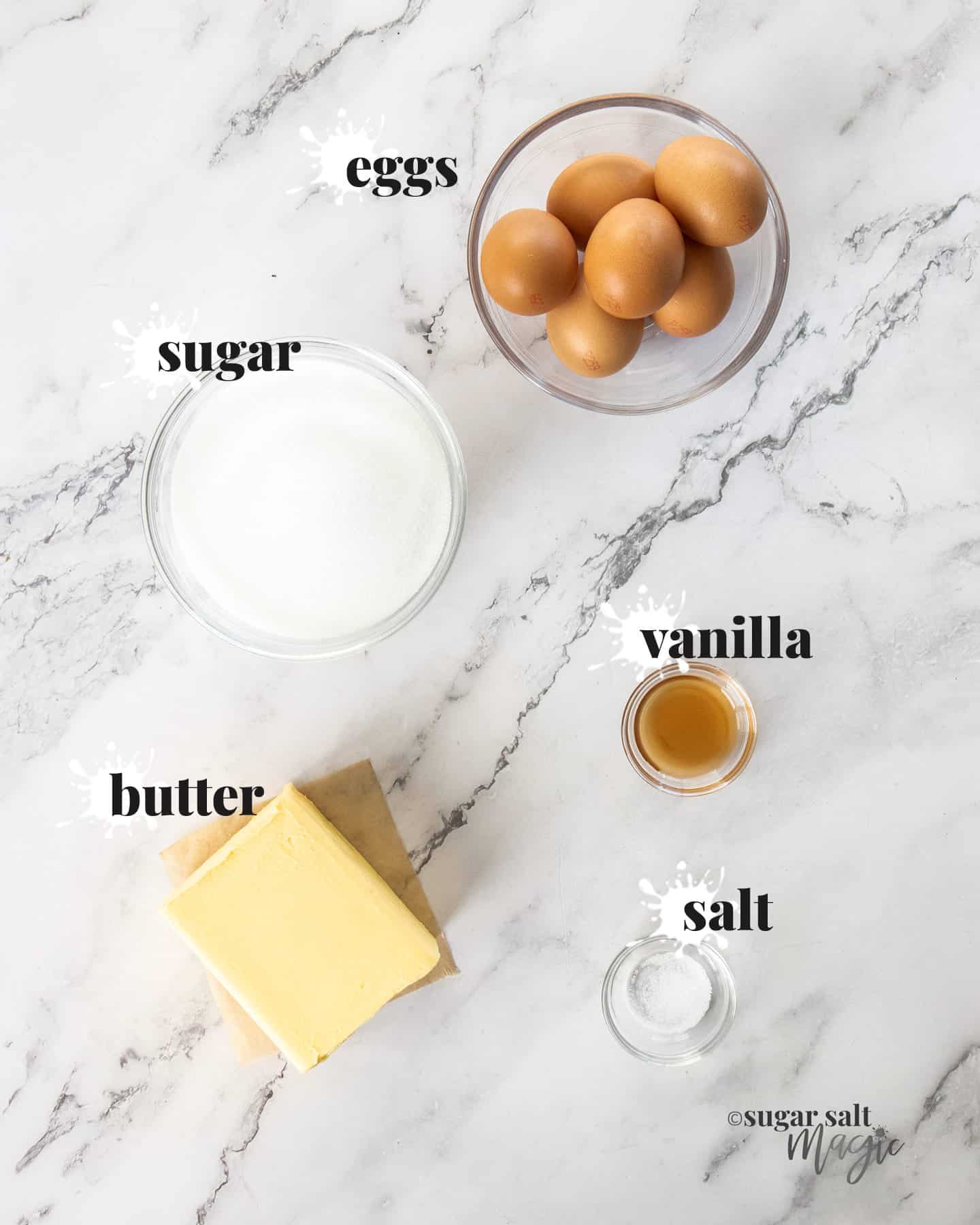
Detailed quantities and directions in the recipe card below.
- Eggs: For this recipe, you just need the egg whites, from fresh eggs, and it’s best to weigh them to get the right amount. You can use up your yolks in some pastry cream.
- Sugar: You want just white granulated sugar for this recipe – even better if you use caster (superfine) sugar as it dissolves quicker. Don’t use icing / powdered / confectioners sugar.
- Butter: The third main component is butter and you could make SMBC with just these top 3 ingredients. Use unsalted butter so that you control the salt level and real butter, no margarine or replacements.
- Vanilla extract: This SMBC has vanilla added to make it a vanilla Swiss buttercream. You can also use vanilla bean paste. Don’t use essences which are synthetic flavourings. You can find out more about flavouring SMBC later in this post.
- Salt: A little salt is always great for balancing flavours, even in desserts.
Helpful tools
- Saucepan: You’ll use a saucepan to simmer some water.
- Heat proof bowl: This will sit over your saucepan of simmering water.
- Balloon whisk: You will need to be constantly, though not vigorously, whisking the meringue with this.
- Candy thermometer or instant read thermometer: While not absolutely necessary, it’s useful for making sure your eggs have definitely reached a safe to eat temperature.
- Stand mixer or handheld electric beater: I find a stand-mixer best since you do need to be beating for quite some time and it will allow you to have your hands free.
How to make Swiss meringue buttercream
While it may look or sound complicated it really isn’t. Swiss meringue buttercream frosting is all about learning it’s basic rules and once you do, there’ll be no stopping you.
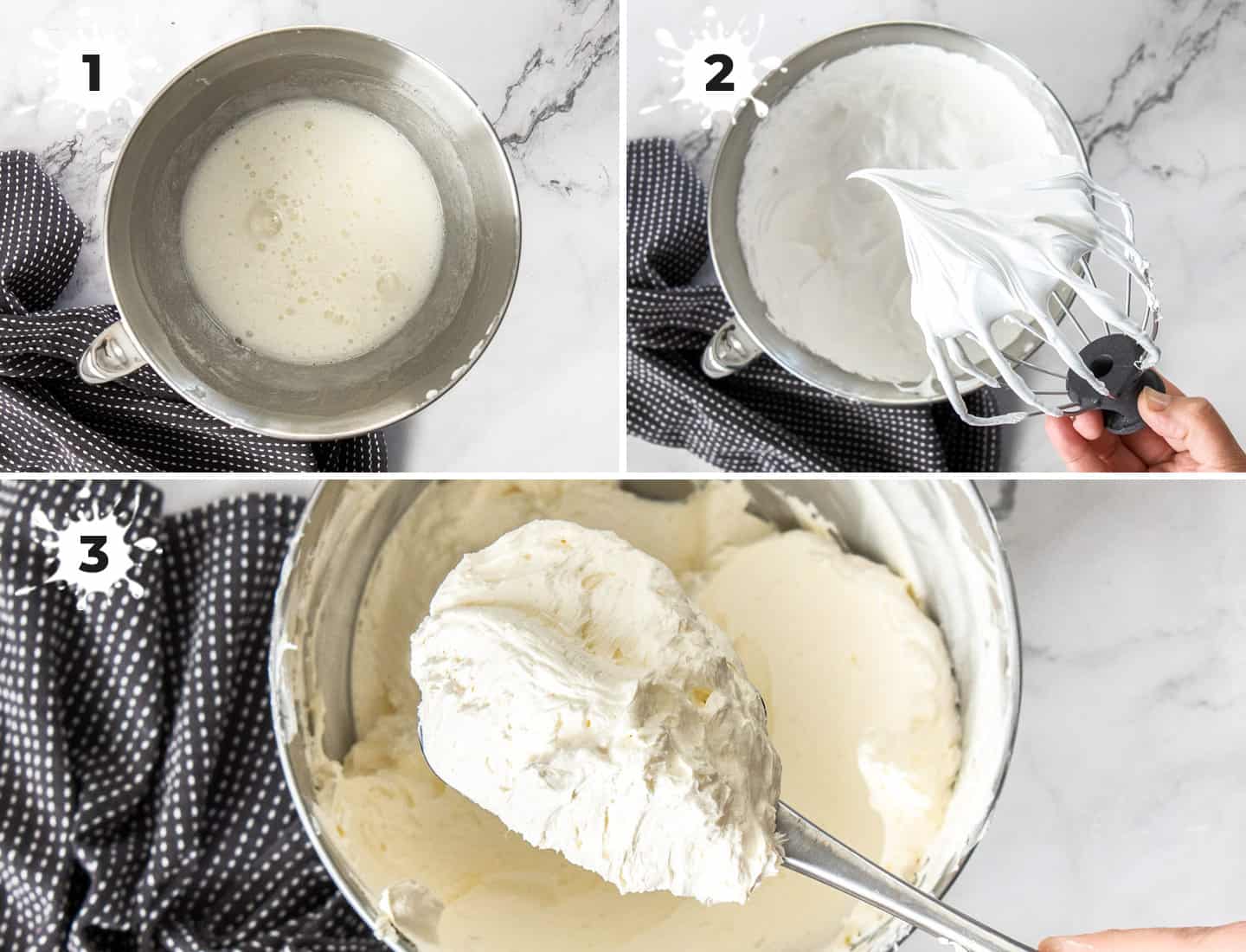
See the recipe card below for the full recipe details.
- Clean your equipment: The slightest bit of grease residue can cause your egg whites not to whip, so, when making meringue, it’s always a good measure to clean everything first. I rub a little vinegar or lemon juice over everything and rinse well before drying it off.
- Separate the eggs: Crack the eggs over a small bowl and move the yolk back and forth between both sides of the egg shell, allowing the white to drop into the bowl below. Place that white into your mixing bowl and repeat with the rest. Doing it this way ensures that if you break one of the yolks (aka fat), you don’t ruin all the whites, just the one you’re working on.
- Combine the sugar and whites over heat: Add the sugar to the egg whites and whisk well, then place the bowl over your simmering water. Whisk it gently but constantly for 4-5 minutes until it reaches 71C / 160F on a thermometer. Also rub a little between your fingertips to make sure there are no sugar grains left.
This mixture will start out gloopy and thick and will thin out and be smooth by the time it’s done. - Whip the meringue: Beat the mixture at high speed until it reaches stiff peaks. You’ll need to use an electric handheld mixer or stand mixer with whisk attachment (best). This will take around 15 minutes but will depend on your environment and weather. It may take a little less time or a little longer.
- Add the butter: Once the meringue is at stiff peaks you may need to let it sit for 5 minutes for both the machine and meringue to cool. If you add butter to warm meringue, it will melt and you’ll end up with Swiss buttercream soup.
Once at room temperature and the bowl no longer feels hot, using the paddle attachment, add the butter one tablespoon at a time letting each fully incorporate before adding the next. - Add flavouring: Once all the butter is added, you should have a thick, whipped buttercream. Add the vanilla and salt and count to 20 while it beats to mix it right through.
- Press out the air bubbles: After all that beating, you can imagine how aerated the frosting is. This can lead to air bubbles making the frosting not look smooth.
Using a silicone spatula, push the buttercream it to one side of the mixing bowl. Now pull and press it against the other side, then repeat until it’s looking smoother. Be careful not to deflate it entirely though – a bit of fluffiness is good for the texture.
What are stiff peaks?
Meringue with stiff peaks will not drop or flop over when turned right side up, like below. When you pull the whisk out, the meringue will be glossy, smooth and have a sharp peak and gravity will not make it droop over.
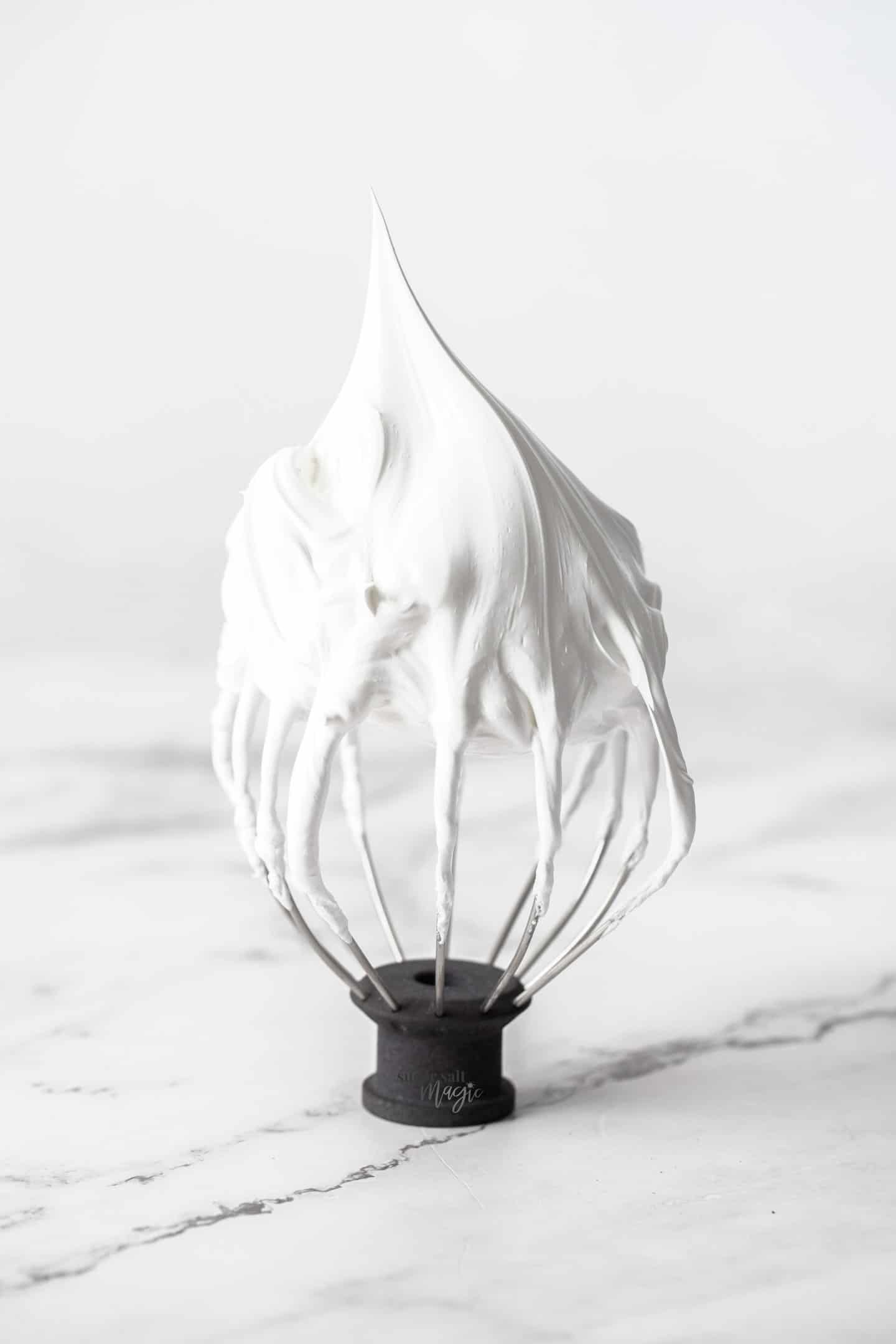
How to flavor Swiss buttercream?
You can turn your Swiss buttercream into just about any flavour imaginable. Add flavouring after all the butter has been added the buttercream is technically ready to use.
- Extracts: Try other natural flavouring extracts, from lemon to almond and everything in between. Be careful with stronger flavours like peppermint extract, adding half the amount to start with.
- Chocolate: Add a little melted chocolate to make chocolate Swiss meringue buttercream. Add about 150g melted chocolate or a combination of melted chocolate and cocoa.
- Caramel: Add ½ cup of thick caramel sauce to the buttercream.
- Berry: Try adding good quality jam or freeze dried fruit powder to the mix.
You could try adding coffee too, or just try my coffee buttercream.
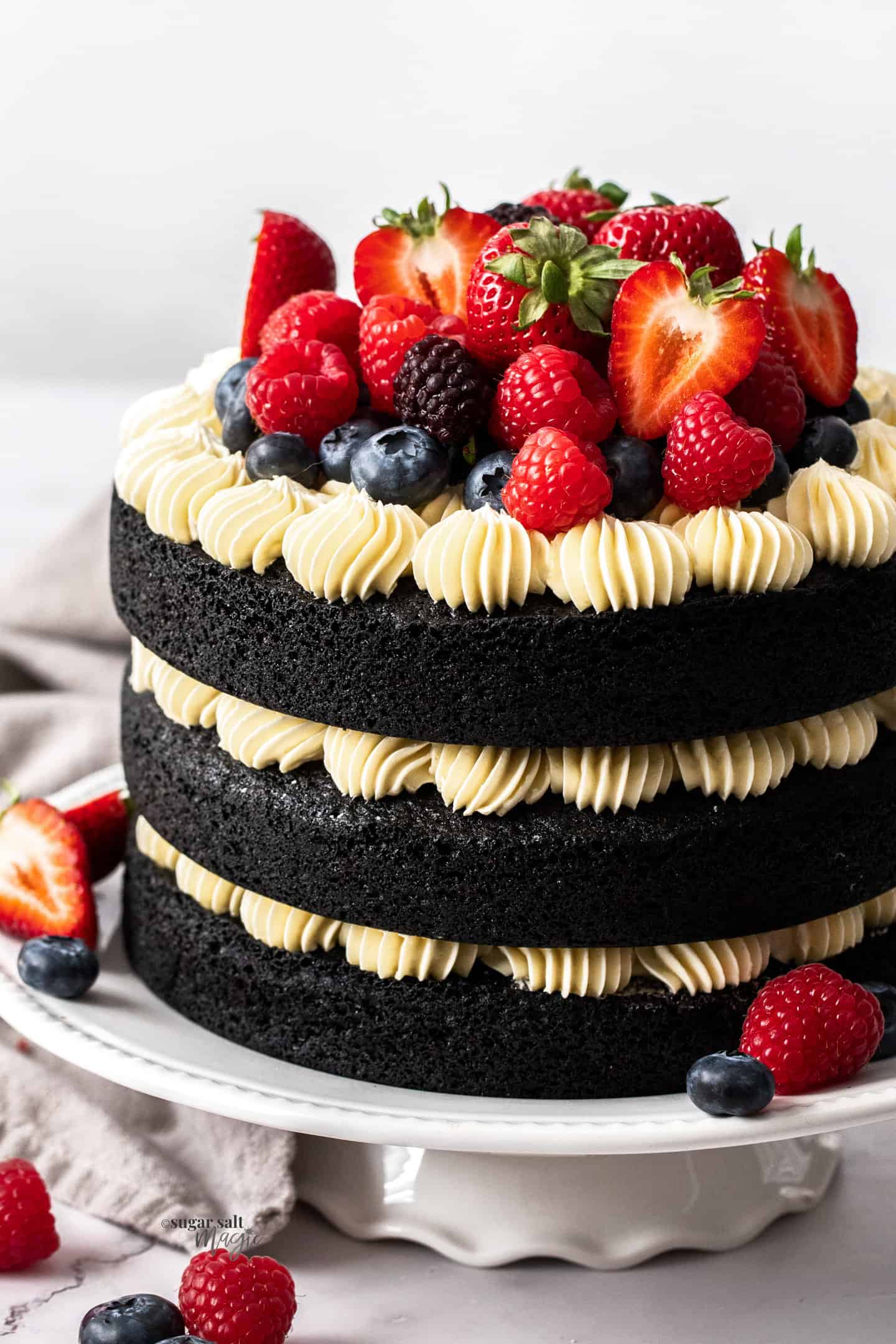
Troubleshooting guide
Meringue not whipping?
This could be caused by a number of things including a little egg yolk or grease getting into the egg whites. Make sure to clean your bowl out with vinegar or lemon juice before starting and separate your eggs one by one into a separate bowl so you can make sure none have any bits of yolk.
Also, higher humidity may cause issues with egg whites whipping. Sometimes you’ll just need to whip a bit longer and others it might be better to make the buttercream first thing when there is less humidity and heat in the kitchen.
Grainy texture
This could be caused by not making sure all the sugar crystals dissolved while over the simmering pan of water. Use caster / superfine sugar as it will dissolve quicker and always make sure to test a little between your fingers before beginning the whipping. All that said, continue beating it a little longer and the crystals should dissolve.
Why does it look curdled?
This isn’t all that rare, that your SMBC can have a curdled look. Nine times out of ten you just need to keep beating and it will eventually turn smooth and gorgeous. If it’s only getting more curdled and thick, place the bowl back over your simmering water again just for a minute or so. Heating the sides of the bowl, will allow a little of the buttercream to melt, then you can beat it again and it will become creamy and smooth.
Why is my buttercream soupy?
If your Swiss meringue buttercream turns liquidy or soupy, it may be due to adding the butter before the meringue was cool enough. Adding butter to warm meringue will cause it to melt. Just place the bowl into the fridge for 10-15 minutes, then take it out and continue.
How to thicken Swiss meringue buttercream
Similar to the last question, if your buttercream isn’t thickening up and won’t hold it’s shape, it could be due to melted butter or maybe your butter was too soft to begin with. Just place it in the fridge for 10 minutes, then take it out and beat again. It should thicken up perfectly.
How to smooth Swiss meringue buttercream
Sometimes you’ll notice a lot of air bubbles in the buttercream after beating for such a long time or if your beater was turned up too high. Use a spatula to press the buttercream against the sides of the mixing bowl to push out the large air bubbles and smooth it out.
How do I make my Swiss meringue buttercream white?
The colour of your buttercream will depend largely on how yellow your butter is. Use a paler butter for a white colour. You can get white food gels which can help or even the tiniest little bit of purple (I’m talking the tip of a toothpick size) added in will actually whiten it. You can also try substituting a little of the butter with shortening for a whiter look.
Why does it get so firm in the fridge?
Having a lot of butter in this frosting, it will become quite solid when refrigerated. Just remove it from the fridge and let it come to room temperature. You’ll likely need to give it another whip for 1-2 minutes to get it smooth again.
My beater is burning up – can I stop?
Yes, by all means, if your beater is feeling too hot, you can stop and just let it cool down, then pick right back up where you left off.
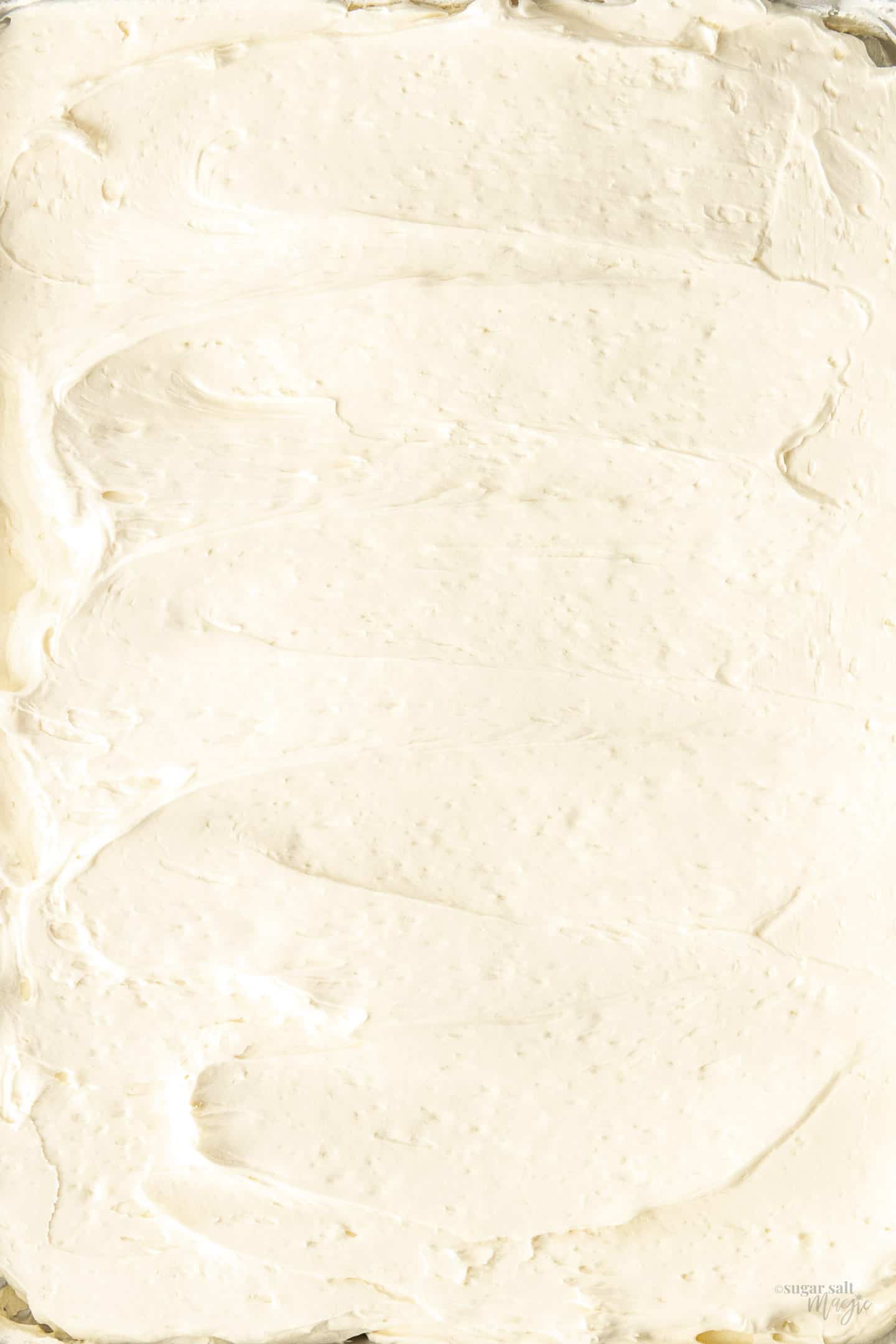
How to store Swiss meringue buttercream
- Room temp: Swiss buttercream can be stored at room temperature for a day or so (room temperature being around 20C / 68F. Any higher than that and you need to store it in the fridge.
- Fridge: If it’s still in the mixing bowl, you can take it out an hour before you want to use it and give it a quick beat up to get it smooth. If it’s already on cupcakes or a cake, just take them out an hour before serving to let it soften a little. It will refrigerate well for up to 5 days. Keep it well covered with plastic wrap.
- Freezer: Swiss meringue buttercream can be frozen too for up to 3 months in an airtight container. Let it thaw before re-whipping until creamy.
FAQs
Does this frosting need to be refrigerated?
As long as the weather is not humid, this frosting is stable and safe at room temperature for a day or two. For any longer than this, store it in the refrigerator and take it out 1 hour before you want to use it. It will need to be given a bit of a whip again to get it creamy and smooth.
If it’s already on cupcakes or a cake, the same rules apply, but you won’t need to whip it. Just pull them out of the fridge an hour before you want to serve.
Is this buttercream safe to eat?
Provided you cook the eggs to the correct temperature of 71C / 160F, then yes, this is safe to eat. The eggs are pasterurised at this stage and no longer raw.
How do you color Swiss buttercream?
You can add gel colourings to Swiss buttercream very easily (not liquid as they add too much liquid to the frosting). Add it with the flavouring at the end.
Is Swiss meringue buttercream stable?
SMBC is stable at room temperature though on hot days or in very humid weather it can melt so, if it’s warm where you are or humid, keep your treats stored in the fridge, taking them out an hour before serving.
Can this be used under fondant?
Swiss buttercream can be used in cakes beneath fondant too.
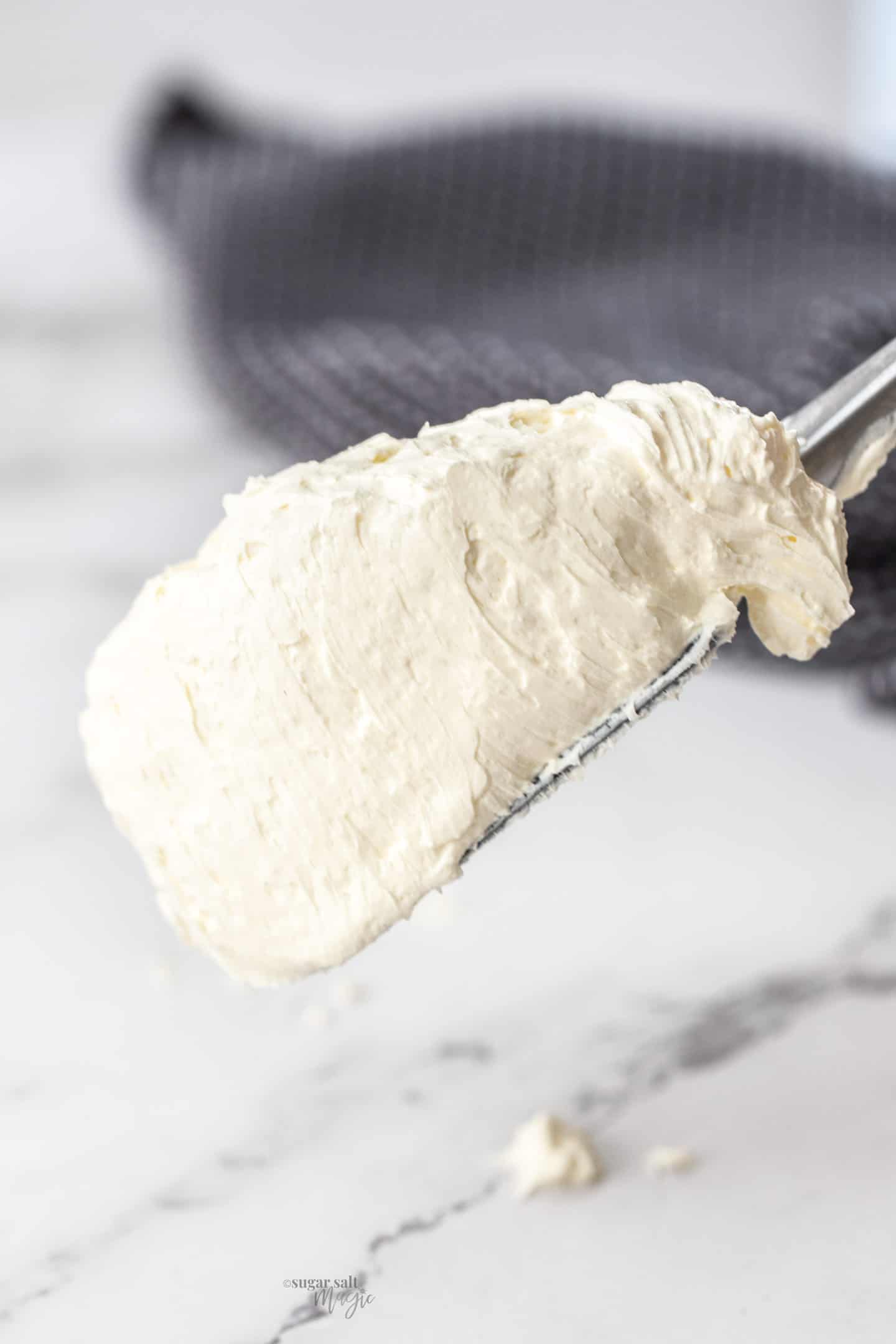
If you try this Swiss meringue buttercream recipe, please take a moment to leave a rating and comment below. I love hearing from you and it helps other readers too! You can also take a photo and tag @sugarsaltmagic on Instagram.
How to use Swiss meringue buttercream
- Try it on vanilla cupcakes
- Try it on chocolate cupcakes
- It works beautifully in a layered cake like this one and this Black Velvet Cake
Never Miss a Recipe!
Get the latest recipes straight to your inbox!
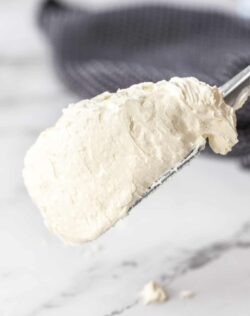
Ingredients
- 180 g egg whites (roughly 6 eggs, notes)
- 336 g caster / superfine sugar (1 2/3 cups)
- 340 g unsalted butter, slightly softened but cool and not greasy (3 sticks / 1 1/2 cups)
- 2 teaspoons vanilla
- ¼ teaspoon salt
For best results, always weigh ingredients where a weight is provided
Instructions
- Rub vinegar around the inside of your mixing bowl, rinse out and dry. This will remove any grease particles that may interfere with the meringue whipping.
- Heat about 1 inch of water in a medium saucepan until simmering.
- Add the egg whites to a large heat-proof mixing bowl, then the sugar. Whisk together with a balloon whisk until combined.
- Place the bowl over the simmering water and continue to gently whisk and stir for around 5 minutes, until the temperature of the mixture reaches 71C / 160F. Rub a little of the mixture between your fingers to make sure there are no sugar granules left. If there are still granules, remove from heat and keep stirring until they’re gone. You can put it back over the heat if it’s taking a long time.
- While still hot, place the bowl in your stand mixer and fit a whisk attachment. Whisk on medium-high speed until the meringue reaches stiff peaks, making sure the bowl and meringue have cooled to at least room temperature. If you have stiff peaks but it’s not cooled enough, you may set it aside until it does. Don’t add butter if it’s still warm or it will melt.
- Swap to the paddle attachment, then add the butter about 1 tablespoon at a time and beat at medium-high, until it’s mixed in before adding the next tablespoon. Continue like this until it’s all combined.
- It should be looking thick, smooth and creamy. If it’s not looking thick or holding it’s shape, place the bowl in the fridge for 10 minutes before whipping again. It should thicken up.
- Add the vanilla and salt and mix for a good 20 seconds to make sure it’s all combined.
- The swiss meringue buttercream is now ready to use.
Notes
- This recipe will work best if you weighh the egg whites and sugar.
- Granulated sugar will work but caster / superfine is best as it dissolves quicker. Don’t use icing / powdered.
- Yield 4 cups, which is enough for piping the 8 inch, 3 layer cake you see in the post. It will frost 12 cupcakes generously.
- If the buttercream is looking soupy or runny, just place it in the fridge for 10 minutes, then whip again and it will thicken up.
- If you’re mixer is overheating, feel free to stop for a little to let it cool.
- Swiss meringue buttercream will keep for 1-2 days at room temp (20C / 68F) or in the fridge for up to 5 days.
- If you store it in the fridge, unless already piped onto a cake or cupcakes, you can let it come to room temperature and give it a whip to make it smooth and creamy again.
- If the mixture looks curdled at any point, don’t worry, it’s quite common. Just keep beating and it will come together.
- For more tips on flavouring or troubleshooting and how to store swiss meringue buttercream, please see the post.
- Calories shown are per cup of frosting.
This post may contain affiliate links that earn me a small commission for my referral, at no extra cost to you. Thank you for supporting Sugar Salt Magic.

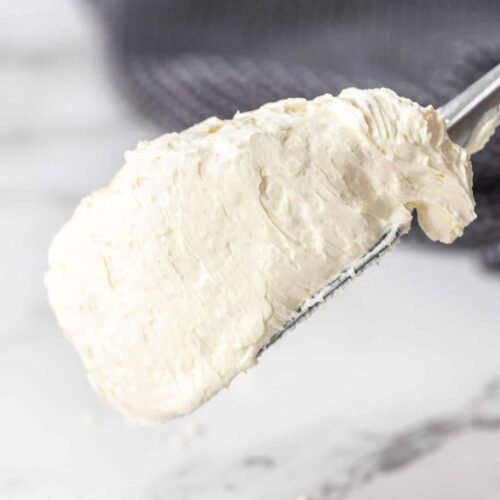
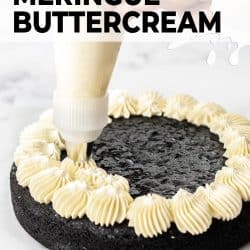
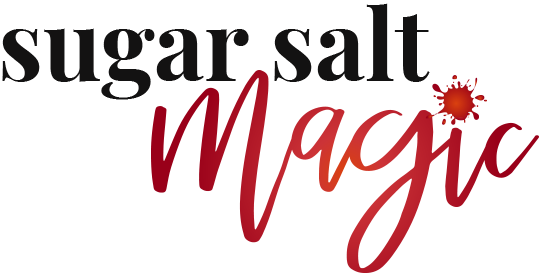
2 Comments on “Swiss Meringue Buttercream Recipe”
EXCELENT RECIPE
So happy you love it Hector.